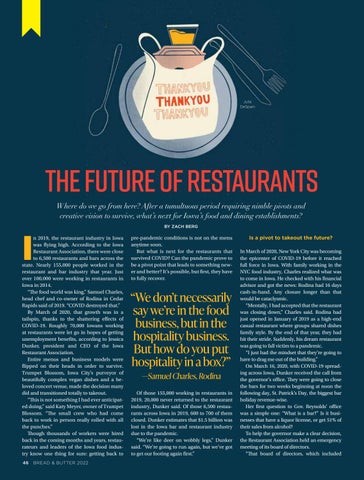Julia DeSpain
The Future of Restaurants Where do we go from here? After a tumultuous period requiring nimble pivots and creative vision to survive, what’s next for Iowa’s food and dining establishments? BY ZACH BERG
I
n 2019, the restaurant industry in Iowa was flying high. According to the Iowa Restaurant Association, there were close to 6,500 restaurants and bars across the state. Nearly 155,000 people worked in the restaurant and bar industry that year. Just over 100,000 were working in restaurants in Iowa in 2014. “The food world was king,” Samuel Charles, head chef and co-owner of Rodina in Cedar Rapids said of 2019. “COVID destroyed that.” By March of 2020, that growth was in a tailspin, thanks to the shattering effects of COVID-19. Roughly 70,000 Iowans working at restaurants were let go in hopes of getting unemployment benefits, according to Jessica Dunker, president and CEO of the Iowa Restaurant Association. Entire menus and business models were flipped on their heads in order to survive. Trumpet Blossom, Iowa City’s purveyor of beautifully complex vegan dishes and a beloved concert venue, made the decision many did and transitioned totally to takeout. “This is not something I had ever anticipated doing,” said Katy Meyer, owner of Trumpet Blossom. “The small crew who had come back to work in person really rolled with all the punches.” Though thousands of workers were hired back in the coming months and years, restaurateurs and leaders of the Iowa food industry know one thing for sure: getting back to 46
BREAD & BUTTER 2022
pre-pandemic conditions is not on the menu anytime soon. But what is next for the restaurants that survived COVID? Can the pandemic prove to be a pivot point that leads to something newer and better? It’s possible, but first, they have to fully recover.
“We don’t necessarily say we’re in the food business, but in the hospitality business. But how do you put hospitality in a box?” ––Samuel Charles, Rodina Of those 155,000 working in restaurants in 2019, 20,000 never returned to the restaurant industry, Dunker said. Of those 6,500 restaurants across Iowa in 2019, 600 to 700 of them closed. Dunker estimates that $1.5 billion was lost in the Iowa bar and restaurant industry due to the pandemic. “We’re like deer on wobbly legs,” Dunker said. “We’re going to run again, but we’ve got to get our footing again first.”
Is a pivot to takeout the future? In March of 2020, New York City was becoming the epicenter of COVID-19 before it reached full force in Iowa. With family working in the NYC food industry, Charles realized what was to come in Iowa. He checked with his financial advisor and got the news: Rodina had 16 days cash-in-hand. Any closure longer than that would be cataclysmic. “Mentally, I had accepted that the restaurant was closing down,” Charles said. Rodina had just opened in January of 2019 as a high-end casual restaurant where groups shared dishes family style. By the end of that year, they had hit their stride. Suddenly, his dream restaurant was going to fall victim to a pandemic. “I just had the mindset that they’re going to have to drag me out of the building.” On March 16, 2020, with COVID-19 spreading across Iowa, Dunker received the call from the governor’s office. They were going to close the bars for two weeks beginning at noon the following day, St. Patrick’s Day, the biggest bar holiday revenue-wise. Her first question to Gov. Reynolds’ office was a simple one: “What is a bar?” Is it businesses that have a liquor license, or get 51% of their sales from alcohol? To help the governor make a clear decision, the Restaurant Association held an emergency meeting of its board of directors. “That board of directors, which included







